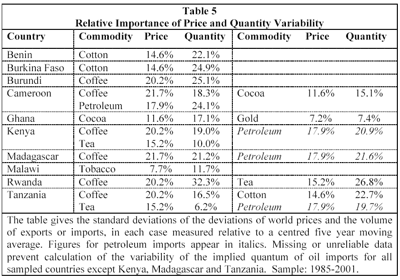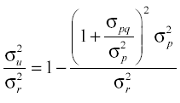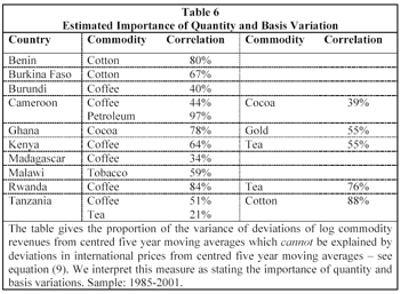Price-based schemes insure countries against movements in prices but not against quantity variations. Table 5 compares the extent of price and quantity variations for the major commodity exports of the ten countries in our sample23. The table also gives comparable figures for petroleum imports for the three countries for which these data are available.

Considering only the export statistics, price variability averages 15.9% whereas quantity variability averages 18.9%, and in 11 of the 17 tabulated country-commodity pairs, quantity variability exceeds price variability. Furthermore, this is also true in the three cases where we have reliable oil import data. Overall, quantity and price variability appear to be of comparable magnitude, with the prevalent tendency being for quantity variability to exceed price variability.
This finding echoes Lim (1991) who found that “volume instability is more pronounced than price instability at the country level”. According to Lim, the major cause of quantity uncertainty was country-specific supply factors such as weather conditions, strikes (for mineral commodities) and socio-political factors. Civil war has become a further significant source of quantity variability over the past decade.
Of course, price and quantity movements will not be independent, and some of the quantity variation may be the consequence of price variations. We may analyze the extent to which this limitation is important by means of a simple decomposition.
Using a different notation
from the remainder of this paper, write the export revenue from a commodity as R, its price as
P and the quantity exported as Q. We use lower case letters to denote the demeaned
logarithms of the corresponding upper case variables. It follows that 
Denote

for any variable x and the covariance  for any pair of variables x and y. Finally, write the quantity-price regression as q=
ß p+u . Since p and u are
uncorrelated by construction, it follows that
for any pair of variables x and y. Finally, write the quantity-price regression as q=
ß p+u . Since p and u are
uncorrelated by construction, it follows that

The ratio

measures the extent of revenue variation that cannot be explained by contemporaneous price deviations and must therefore be attributed either to movements in the price basis or to uncorrelated quantity movements. Table 6 gives this ratio for the commodity exports we have considered in the simulation exercises. In general, prices explain less than 50% (and in some cases substantially less than 50%) of revenue movements.
In summary, both basis and quantity risk appear to be significant problems for price-based schemes of the form we consider in this paper. Movements in world prices typically account for less than half the variation in commodity export revenues for indebted countries. The implication is that non-discretionary hedges based on world prices will not offer very adequate insurance against revenue fluctuations at the aggregate level24. This conclusion is not new but previous research, particularly that by Goreux (1980) and Lim (1991), which reached the same conclusion, has not received adequate attention.

None of this implies that price effects are unimportant. Rather, the arguments underline that these are not the only important factor. But these factors do explain why schemes, such as those we consider, which rely only on prices, may be less effective than one might have hoped.
23 Sources for volume data: agricultural commodities: FAO; gold: World Bureau of Metal Statistics; petroleum: International Energy Association.
24 In Gilbert and Tabova (2003), we looked in detail at three of the ten countries for which we have conducted simulations: Burundi (the country for which the scheme performs best), Ghana (an intermediate example) and Benin (the country for which the scheme performs least well). Each of the three countries we have considered tells a different story. The common element is that movements in international commodity prices are not, in general, the major factor responsible for movements in reported export revenues and import expenditures, even in countries which are highly dependent on these commodities. In Burundi, where coffee prices do account for a significant proportion of the variation of coffee revenues, there were two major falls in revenue over the nineteen nineties which were not due to price movements. In Ghana, movements in commodity export revenues relate more to structural factors as to price movements. In Benin, data quality issues are sufficiently acute as to lead to the worry that the results may be dominated by measurement errors, preventing any clear substantive conclusion beyond the concern that the local and world cotton prices appear too weakly related for a hedge scheme to be viable.
By Prof. Christopher L. Gilbert, Prof. Alexandra Tabova
Next: Conclusions
Summary: Index